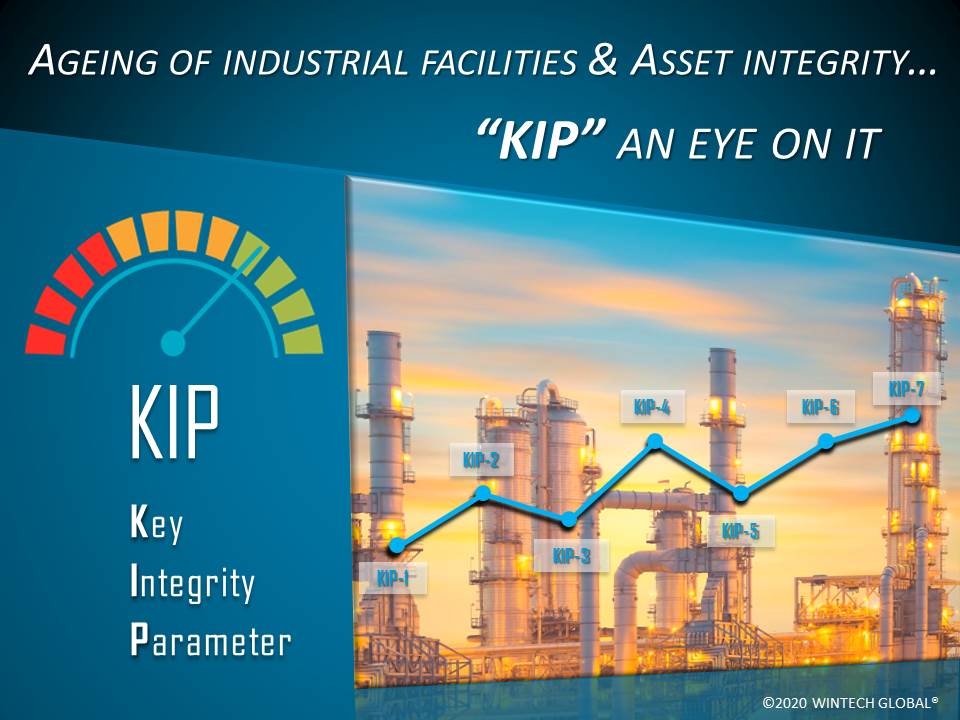Posted on 19 February 2020
“KIP” a unique indicator
to gauge process equipment condition & integrity management
For decades, the operators of industrial sites have often been the owners or their subsidiaries. As a result, most of them were the initiators of the construction and had followed the changes and other ups and downs that characterize the industrial history of a site.
This had the advantage of consolidating information over time by drawing on the individual skills and collective memory of the team.
Nowadays, the situation has changed to some extend…
Indeed, in a world in perpetual motion,
– People CHANGE jobs more regularly, taking with them the stories, experiences and skills they have acquired, which are often very difficult to pass on,
– Sites are sold and CHANGE hands on the basis of financial results and operating performance prospects, it being understood that for new buyers it is often very difficult to objectively qualify the condition of the site, which is the subject of the transaction,
– Operating conditions CHANGE to optimize business models, resulting in equipment moving away from the Operating Window for which they were originally designed.
To all these CHANGES inherent to the life of industrial sites, is added the fact that installations are ageing, CAPEX are being reduced and maintenance budgets are being optimized.
These parameters, whether concomitant or not, all increase the risk of incidents. The variation in insurance policies follows this trend, putting additional pressure on operators and owners.
To overcome the difficulties inherent to all these CHANGES, connected systems, Industrial Internet of Things (IIoT) and high-performance numerical models allow operators to benefit from immediate and transversal reading as well as optimal responsiveness, sometimes even basing their decisions on predictive models using mathematical models or Artificial Intelligence (AI).
However, the use of new technologies, which are now becoming essential for operating sites in optimal conditions, particularly in terms of overall efficiency or energy consumption, is not sufficient to characterize the “health condition” and integrity management of an equipment…

Whatever the site, its age or its level of use of new technologies, it is therefore essential to regularly:
– Qualify the real condition of the installations by interpreting the results of the inspection campaigns and comparing them with historical logs,
– Adjust the methods and means of integrity management according to historical data and new degradation modes,
– Assess the ability of equipment to operate within extended operating windows.
In the context of these “cross-checks”, the modes of damage must be exhaustively identified and possible adaptations implemented, the Management Of Change procedures must be challenged, and all incidents, even minor ones, must be systematically analyzed in depth.
Of course, the installations receive all the attention they deserve from the operators on a daily basis, but a check-up from time to time proves to be particularly beneficial to objectively qualify the situation and to accompany the “tumultuous” life of these highly solicited installations.
Whether in an operating context or from an acquisition perspective, the teams (internal or external) designated to carry out this cross-checking and assessments must be independent of the operators of the concerned asset. As part of their analysis, they must be able to integrate all the influencing parameters, consolidate the views of the personnel invested on a daily basis in the proper functioning of the installations, interpret the results reported by the various inspections on the equipment, consolidate the remaining lifetime of ageing equipment and its ability to be (re)brought into operation, etc…
Of course, these audit-like interventions are not intended to supplant the teams, means or procedures in place; they are nevertheless an effective way of consolidating or adjusting a system aimed at ever better controlling the integrity of equipment and maintaining the reliability of installations in a constantly changing environment.
Within the framework of its Audits, Wintech Global proposes the implementation of the “KIP”(*) Integrity Parameter as an indicator for the qualification of the condition of an equipment and the level of performance of the means and procedures implemented for its advanced management. This Index, which is updated during successive assessments, makes it possible to identify any points of weakness and to monitor changes over time. It is calculated on the basis of the 3 following factors:
– “Equipment condition”
– “Inspection & Monitoring”
– “Documentation & Procedures”
The indicator thus determined provides essential quantitative information, not only to support the continuous improvement process, but also to demonstrate the level of integrity of the site to third parties such as supervisory authorities, shareholders or insurers.
(*)KIP : Key Integrity Parameter by Wintech Global
